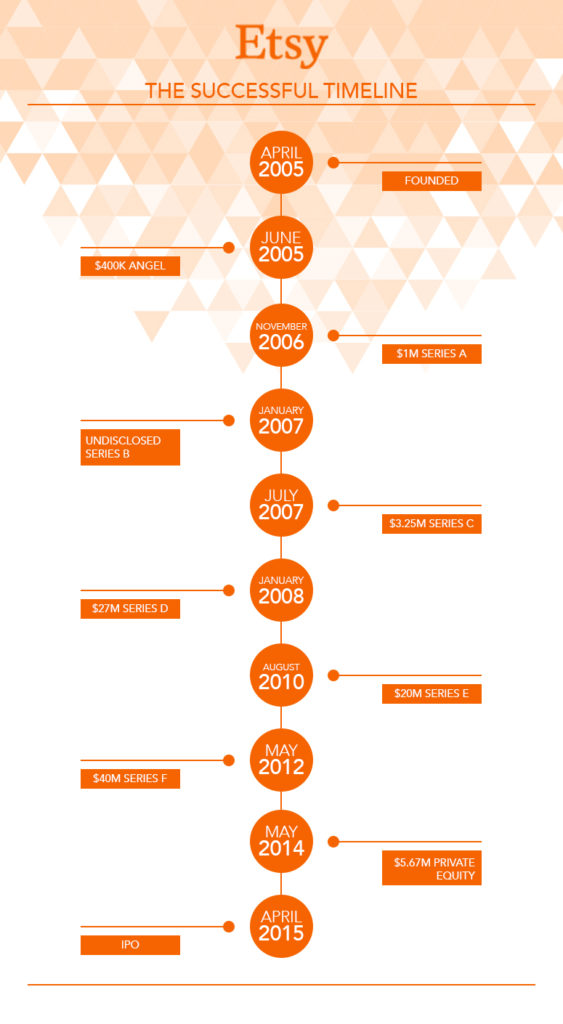
What is Etsy?
Etsy is an e commerce marketplace that enables artists to sell handmade unique products to interested buyers around the world. The business model of Etsy can be described as somewhat similar to Amazon or eBay, but with the difference that Etsy provides an amazing value to both buyers and sellers. On one side Etsy helps sellers sell their handmade crafts and earn a living while on the other side it helps buyers own one of a kind products. This fact has led to the massive growth of Etsy. It started as a simple website in year 2005 and is now listed as a public company with over $360 Million of total funding.
Unlike Amazon and eBay which are based on the horizontal model selling almost everything on their platform, Etsy has chosen a vertical platform model by confining itself to selling only craft items in various categories. Along with insights into Etsy’s business model and revenue generation strategies, let’s also go through its customer segments, value propositions and some other interesting facts.
Informational Facts about Etsy:
Founders: Robert Kalin, Haim Schoppik, Jared Tarbell and Chris Maguire.
Founded on: June 18, 2005.
Company Headquarters: Brooklyn, New York, USA.
Funding received: Total of $97.26 Million in 8 rounds.
Etsy became an IPO on: 1st April, 2015. Etsy’s IPO is the largest IPO till date for a New York-based venture-backed startup.
Number of users: Over 25 Million users.
Number of employees: As of year 2015, Etsy has about 400 employees.
Etsy had a rule that everything sold on the platform should be handmade but to grow further, they had to drop this rule in year 2013. Total sales in year 2013 reached $1 Billion.
Etsy’s Successful Timeline
 Salient Features of Etsy
Salient Features of Etsy
Etsy can be seen as a simple e-commerce website based on the marketplace model that sells goods and earns revenue from commission. Even after having a simple business model, Etsy has got some cool features as mentioned below.
- Etsy only lists unique products in the art & craft, handmade and vintage category.
- Vintage products can only be listed if they are 20 years old.
- Sellers can create a shop.
- Etsy offers global shipping.
- Each seller has a feedback which helps buyers make the decision to buy.
- Buyers have different options to pay money which are chosen by the seller.
- Etsy is more popular among women. It has 67% women members.
Etsy’s Value Propositions
The success of Etsy can be credited to the value the company provides to its buyers as well as artists.
Sellers
Etsy enables artists to put their items on display in front of the world.
Sellers can create a shop on Etsy and name it according to their wish.
They have the option to add as many items to their shop as they like.
Sellers can choose the selling price of their items according to what they think is right.
Sellers can add tags to their items which lets their products to be searched easily.
Buyers
Etsy enables buyers to browse unique handmade products from artists across the globe.
Buyers can even buy vintage items.
Can get a product delivered to their country with international shipping options.
Etsy’s Customer Segments:
Sellers
Sellers are individual artists who make handmade products.
Some sellers are small industries which manufacture handicrafts.
Artists who want to earn money by selling their products.
Artists who want an online shop.
Buyers
Buyers for Etsy are those who buy craft and vintage items.
People who want to own one of its kind unique products.
Etsy Business Model Canvas
We, here at JungleWorks, analysed all 9 segments as mentioned in the Business Model Canvas in regard to Etsy. Here’s a detailed chart for the same:

How Etsy earns money (Etsy Revenue Model)
Just as Etsy is known for listing unique items on its platform, it is also known for a unique revenue model. The major revenue models of Etsy comprise the following:
1) Etsy charges sellers to list items on its platform. However the fee to list something on Etsy is as low as $0.20, but it contributes a good amount to the overall ,money that etsy makes. The amount of $0.20 is valid for 4 months
2) Apart from the listing fee, Etsy also charges sellers a commission for every sale. The commission fee has been fixed at 3.5%. Sellers have the option to set their own sale price but Etsy cuts a commission of 3.5% from the sale price before paying the money to the seller.
3) Etsy has given some special features to sellers which they can avail by paying an extra cost. These are basically advertising options like making a product as featured product etc. Sellers can showcase their shops and hence have more sales.
4 step model about How Etsy Works
1. Sellers can sign up on the platform and can list items for sale.
Listing items on Etsy is not free. Etsy charges a fee to list each items which is valid for 4 months.
2. Buyers can browse these items and place order for the ones they like.
Buyers can use the advanced filters of Etsy to search for products. Buyers have to option to ask the seller a question or can simply add the item to their cart.
3. Buyers make a transaction on the platform.
All transactions are made through Etsy. Etsy charges a commission of 3.5% from every successful sale and transfers the rest amount to the seller’s bank account.
4. Buyers have the option to rate and review the items.
These reviews are helpful for other buyer who are interested in that product. The rating system helps other buyers to know if the product is good or not.
How and why Etsy became so successful?
The success of Etsy goes to its unique business model. Unlike eBay or Amazon, Etsy chose a narrow domain of art, craft, handicraft and handmade items. No doubt in the fact that Etsy came out as a winner in this segment. But let’s see what made Etsy successful.
If you give a broad look to eBay, Amazon and Etsy, you’ll find that eBay and Amazon also list out such items on their platform but it was the value provided by Etsy which attracted buyers and sellers on its platform.
Word of Mouth Advertising:
Etsy was the only site back at that time which catered to handmade products. Etsy revealed that 67% of its total users are women. The major part of Etsy’s growth came from word of mouth in women circles.
Extended API’s
Etsy has its own API which lets developers tap into the Etsy community and build their own Etsy-powered applications for the web, desktop and mobile devices. Many small businesses have used this approach to sell their products.
Offline Help and Support to artists
Etsy has been there on the ground. The company ran workshops for local crafters and stood there to provide support services including business advice. In some cases, Etsy even gave small loans to artists.
Subscribe to stay ahead with the latest updates and entrepreneurial insights!

Subscribe to our newsletter
Get access to the latest industry & product insights.




























